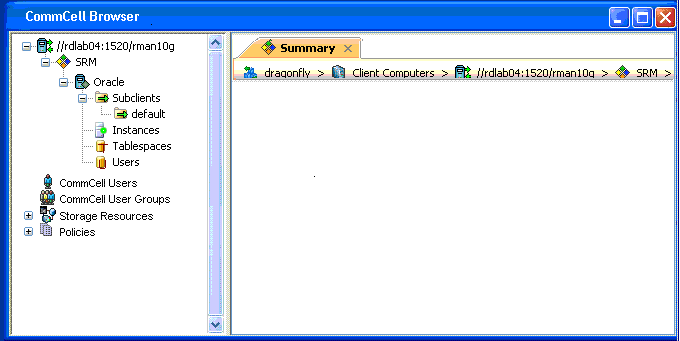
Topics | Related Topics
The SRM Oracle Agent gathers statistics on all levels of the Oracle Database.
Data collected by the SRM Oracle Agent is summarized by many types of reports that may be further customized with user-selected filters and charts in the Report Manager.
For the SRM Oracle Agent, the agent software is installed on a proxy client. For more information on installing the proxy client, see Deployment - SRM Oracle Agent. Once the installation is complete, the agent and the oracle database information must be configured from the client level in the CommCell Console. For step-by-step instructions see, Add Oracle Database.
This agent supports two job types for data collection:
This job collects detailed statistics including information about databases, datafiles, tables, tablespaces, indexes, instances, users, ASM and RMAN. Collections using the Analysis level job for this agent require minimal processing on the proxy server, similar to the Discovery level job, and may be run either throughout the day or during off-peak hours.
This job collects detailed statistics including information about databases, datafiles, tables, tablespaces, instances, users, ASM and RMAN; general information about indexes is also collected. Collections using the Discovery level job require minimal processing on the proxy server, and may be run either throughout the day or during off-peak hours. If you use the Discovery level job, you will not receive the same degree of detail on index related reports as the Analysis level template.
See Reports - SRM Oracle Agent for more information about which reports require Analysis level data collection.
When the SRM Oracle Agent is installed, the following levels are automatically created in the CommCell Browser.
 |
|
| //rdlab04:1520/rman10g: |
Client |
| Oracle: |
Agent |
| default: |
Subclients |
| Instances: |
This level displays Instances information for the SRM Oracle Agent's
client computer. Instances associated with the client computer are
populated under this level after completion of the first Data Collection
operation. For more information, see
SRM
Oracle Agent in Summaries. |
| Tablespaces: |
This level displays Tablespaces information of Oracle Instance for the SRM Oracle Agent's
client computer(s). Tablespaces associated with the Instance are
populated under this level after completion of the first Data Collection
operation. For more information, see
SRM
Oracle Agent in Summaries. |
| Users: |
This level displays Users information of Oracle Instance for the SRM Oracle Agent's client
computer(s). Users associated with the Instance are populated under
this level after completion of the first Data Collection operation. For
more information, see
SRM
Oracle Agent in Summaries. |
Consider the following configuration requirements prior to using the SRM Oracle Agent:
The File System Agents perform data collection and provide report and summary information on logical and physical devices including raw partitions. Database Agents perform data collection on the logical devices and provide reports and summaries on logical devices associated with the database. For Logical/Physical Device Mapping to work on the Oracle Database Agent, Data Collection must be run on the Oracle Database after it is run on the File System Agent located on the computer where Oracle stores its data.
Logical/physical device mapping for Oracle Database is reported only on Windows and Red Hat Linux, only if the database is on a UNIX Raw Volume or File System. Mapping does not work on other operating systems or with ASM (Automatic Storage Management). If the database uses a UNIX Raw Volume, it must be listed in the /etc/sysconfig/rawdevices file.
or more information on summaries for each SRM Agent, see SRM Summaries.
To perform a data collection operation using this Agent, you need a SRM Oracle Agent license, available in the SRM server. The license is consumed when this component is configured on the client computer. See License Administration for more details on license requirements.